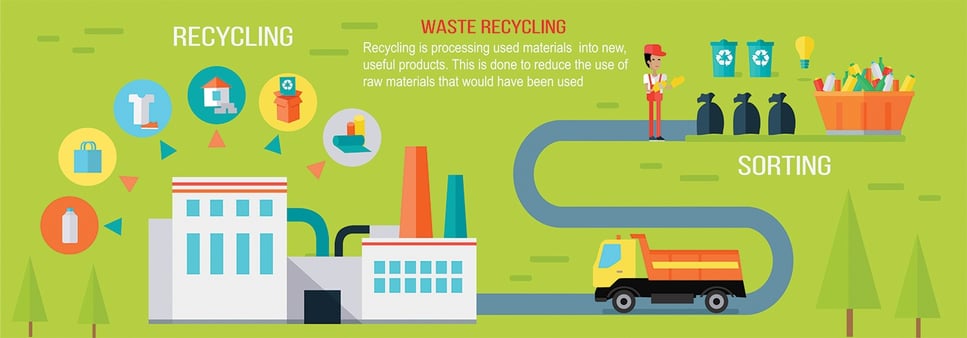
Target: Zero Waste
“Zero Waste” has become an objective for many universities, municipalities, sports venues, building facilities and other organizations – and this objective continues to be driven by the desire to minimize and eliminate waste in order to save money, while also meeting employee and customer expectations for environmental responsibility.
What exactly is “zero waste” – and how can zero waste be achieved?
Zero Waste – A Definition (or Three)
1. Zero waste is defined by the Zero Waste International Alliance as “a goal that is ethical, economical, efficient and visionary, to guide people in changing their lifestyles and practices to emulate sustainable natural cycles, where all discarded materials are designed to become resources for others to use.
2. “Zero Waste means designing and managing products and processes to systematically avoid and eliminate the volume and toxicity of waste and materials, conserve and recover all resources, and not burn or bury them.
3. “Implementing Zero Waste will eliminate all discharges to land, water or air that are a threat to planetary, human, animal or plant health.”
Depending on who you consult, however, there may be some slightly different definitions – as the EPA website states, “Zero waste has been defined in various ways by different entities.” The EPA has a webpage which compiles some of these definitions for reference.
For the most part, each of these definitions includes some form of the following elements:
- Maximizing diversion from the landfill through waste management planning
- Reducing waste at its source through life cycle analysis and system design
- Applying a “cradle to cradle” approach to waste management, as opposed to “cradle to grave”
- Applying metrics: some definitions state “zero waste” means absolutely zero waste to the landfill, while others state zero waste means at least 90% diversion
So now that some working definitions of zero waste have been established, how can zero waste be achieved?
Zero Waste – A Checklist
Zero waste represents an ideal, and is an admirable goal for any organization – and while there is no magic wand which can be waved to achieve zero waste, there are some suggestions which can be very helpful in getting you started on the path to achieving this objective:
- Select a Recycling Coordinator: A Recycling Coordinator conducts a waste audit and determines what can be recycled or otherwise diverted from the landfill. The Recycling Coordinator also selects a waste management hauler, designs the waste management system to fit the needs of the facility, campus or venue, educates employees and building occupants, and tracks waste diversion program progress.
- Conduct a Waste Audit: The waste audit is used to identify all recyclable materials which are currently being thrown away at your facility. Frequently referred to as “dumpster diving”, a waste audit helps you to find out what’s in your trash – how much waste is being generated, how often it is being generated, and where it is coming from. Whether it is misprints at the copy machine or food scraps from the breakroom, much of the “waste” which is generated at a typical facility can be diverted from a landfill.
- Determine Which Materials To Collect: Coordinate your efforts with your City’s regulations and your waste hauler – now that you have completed your “dumpster dive”, what types of materials does your site generate that warrant collection? Have you identified materials such as glass, paper and cardboard? There is typically infrastructure in place to accommodate these materials. Food scraps represent the next frontier in recycling and waste diversion – and the EPA estimates that food scraps and yard waste make up to 20-30% of what is thrown away, and can be composted as opposed to landfilled. Check with your local municipality for options in your area.
- Select Your Collection Contractor: Collection can be provided by a recycling company, collector or waste hauler. Many provide diversion rate statistics to help you measure your progress. Determine which vendor is best suited to help you meet your objectives.
- Design Your Collection System: Keep it simple! Pick containers and locations for collection which make them easy to use. Integrate the transfer of recyclables into the regular waste collection system, have a streamlined transfer system, and locate the storage/pickup area in a central location.
- Promote Employee/Tenant Participation: Educate your employees and building occupants, and celebrate waste diversion successes! Getting to Zero Waste takes teamwork, and it always helps to get everyone involved and making contributions to the overall effort.
Zero Waste – Additional Resources
Check out the CalRecycle website for additional resources regarding zero waste initiatives for municipalities in the State of California, and check out the GrassRoots Recycling Network for additional profiles on some businesses who have reported they have diverted over 90% of their waste from landfills and incineration.
Whether your company is looking to improve your existing waste diversion program, or you are just getting started, WAXIE can assist you from start to finish.
WAXIE Waste Diversion and Recycling
Trojans and Rams Get the Gold for Going Green in 2016, Crossing Zero Waste’s Goal Line
How BigBelly Solar Compactors are Improving Waste Diversion at UCSD


